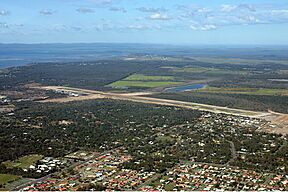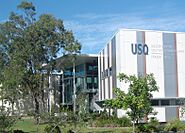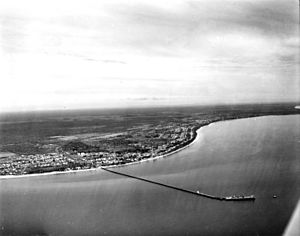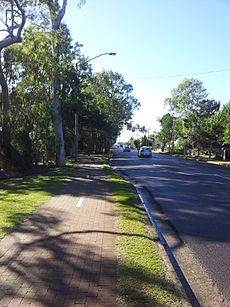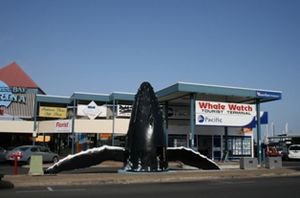Hervey Bay facts for kids
Quick facts for kids Hervey BayQueensland |
|||||||||
|---|---|---|---|---|---|---|---|---|---|
|
View over the city and Hervey Bay Airport towards the Great Sandy Strait
War Memorial in Freedom Park
University of Southern Queensland
Humpback whale in Hervey Bay with K'gari
|
|||||||||
| Population |
|
||||||||
| • Density | 619.3/km2 (1,604/sq mi) | ||||||||
| Established | 1863 | ||||||||
| Postcode(s) | 4655 | ||||||||
| Area | 93.2 km2 (36.0 sq mi)(2011 urban) | ||||||||
| Time zone | AEST (UTC+10:00) | ||||||||
| Location |
|
||||||||
| LGA(s) | Fraser Coast Region | ||||||||
| Region | Wide Bay-Burnett | ||||||||
| State electorate(s) |
|
||||||||
| Federal Division(s) | Hinkler | ||||||||
|
|||||||||
Hervey Bay is a city located on the coast of Queensland, Australia. It's about 290 kilometres (180 miles) north of Brisbane, the state capital. The city sits on a bay that opens to the Coral Sea, protected by K'gari (also known as Fraser Island).
Hervey Bay is famous for tourism, especially for whale watching. It's also a great spot for fishing, boating, and enjoying calm, natural beaches. In 2019, Hervey Bay became the world's First Whale Heritage Site. This award shows its dedication to protecting whales and dolphins.
In 2021, Hervey Bay had a population of 57,722 people. A study in 2010 even suggested that people living in the Fraser Coast area, including Hervey Bay, were among the happiest in Australia!
Contents
- History of Hervey Bay
- People and Population
- Special Places and History
- Getting Around Hervey Bay
- How Hervey Bay is Run
- Weather in Hervey Bay
- Areas within Hervey Bay
- Schools and Learning
- Local Services and Facilities
- News and Media
- Shopping and Business
- Sports and Activities
- Whale Watching Capital
- Sister Cities
History of Hervey Bay
The land where Hervey Bay is located belongs to the Butchulla people. They are the traditional owners of the Fraser Coast region, including K’gari.
The first European to see Hervey Bay was James Cook in 1770. He named the bay "Hervey's Bay" after Augustus Hervey, 3rd Earl of Bristol, a naval officer. Cook didn't realize that Fraser Island was separate from the mainland because the waters were too shallow for his ship to go further south.
Small towns began to grow along the bay, with Pialba being one of the earliest in 1863. For many years, a railway line connected the area to the main North Coast line. This line was important for transporting goods like pineapples and sugar cane. However, road transport eventually took over, and the railway line closed in 1993. Part of the old railway line has now been turned into a walking and cycling path.
Hervey Bay grew quickly from the 1980s onwards. It was officially declared a "City" on 18 February 1984. Even though it became a city, many locals still thought of it as a small seaside town. In 2008, Hervey Bay joined with other nearby areas to form the Fraser Coast Region. The Hervey Bay Library opened in 1997 and is getting a new building soon, expected to be ready by mid-2026.
People and Population
In 2016, Hervey Bay had 52,073 people living there. About 4% of the population were Aboriginal and Torres Strait Islander people. The average age of people in Hervey Bay was 48 years old. Most people (74.6%) were born in Australia, with others coming from England, New Zealand, and other countries. English was the main language spoken at home.
By 2021, the population of Hervey Bay had grown to 57,722 people.
Special Places and History
Hervey Bay has some important heritage-listed sites. K'gari is listed on the World Heritage List, which means it's recognized as a very special place globally. The Woody Island Lighthouses are also listed on the Queensland Heritage Register.
Getting Around Hervey Bay

Hervey Bay is about a 3.5-hour drive north of Brisbane. You can get there by car using the Bruce Highway. It's also about 30 minutes from Maryborough.
You can travel to Hervey Bay by train, connecting from Maryborough West or Howard to the high-speed Tilt Train. The city also has the Hervey Bay Airport, with direct flights from Brisbane, Sydney, and Melbourne. There are also ferries that take passengers and vehicles to Fraser Island.
Old Railway Line
Even though Hervey Bay is growing, there are no plans for a new railway line. The old passenger and freight line used to branch off the main North Coast line near Maryborough. It stopped at stations like Pialba and Urangan. This line was used to transport local goods. The line closed in 1993. The tracks from Nikenbah to Urangan were removed, and the section from Pialba to Urangan was turned into a rail trail for walking and cycling. You can still see parts of the old railway line in Urangan.
How Hervey Bay is Run
Hervey Bay is the biggest town in the Fraser Coast Region. The person in charge of the Fraser Coast Regional Council is the mayor, George Seymour. He was first elected in 2018 and has been re-elected since. Ten councillors are also elected every four years to help run the region.
Hervey Bay is represented in the Queensland Parliament by David Lee. In the Australian Parliament, it's represented by Keith Pitt.
Weather in Hervey Bay
Hervey Bay has a warm, humid climate. This means it has hot, wet summers and very mild, fairly dry winters. The highest average temperature is about 30.3°C (86.5°F) in January, and the lowest average is about 21.8°C (71.2°F) in July. The ocean helps keep the temperatures from getting too extreme.
The area gets about 1022 millimetres (40 inches) of rain each year, mostly in summer and autumn. Sometimes, tropical cyclones can affect the town during summer, but Fraser Island helps protect the bay from the worst of these storms.
| Climate data for Hervey Bay (25º19'12"S, 152º52'48"E, 13 m AMSL) (1999–2024 normals and extremes) | |||||||||||||
|---|---|---|---|---|---|---|---|---|---|---|---|---|---|
| Month | Jan | Feb | Mar | Apr | May | Jun | Jul | Aug | Sep | Oct | Nov | Dec | Year |
| Record high °C (°F) | 35.2 (95.4) |
34.7 (94.5) |
35.4 (95.7) |
32.1 (89.8) |
29.6 (85.3) |
27.6 (81.7) |
26.1 (79.0) |
29.5 (85.1) |
31.2 (88.2) |
33.0 (91.4) |
34.5 (94.1) |
36.8 (98.2) |
36.8 (98.2) |
| Mean daily maximum °C (°F) | 30.3 (86.5) |
30.2 (86.4) |
29.2 (84.6) |
27.1 (80.8) |
24.3 (75.7) |
22.2 (72.0) |
21.8 (71.2) |
22.9 (73.2) |
24.9 (76.8) |
26.6 (79.9) |
28.1 (82.6) |
29.5 (85.1) |
26.4 (79.6) |
| Mean daily minimum °C (°F) | 22.0 (71.6) |
22.0 (71.6) |
20.8 (69.4) |
17.8 (64.0) |
14.2 (57.6) |
11.8 (53.2) |
10.0 (50.0) |
10.5 (50.9) |
14.0 (57.2) |
16.9 (62.4) |
19.1 (66.4) |
21.1 (70.0) |
16.7 (62.0) |
| Record low °C (°F) | 16.0 (60.8) |
16.6 (61.9) |
15.6 (60.1) |
7.0 (44.6) |
4.0 (39.2) |
1.8 (35.2) |
−1.2 (29.8) |
−0.1 (31.8) |
2.9 (37.2) |
6.8 (44.2) |
9.1 (48.4) |
13.4 (56.1) |
−1.2 (29.8) |
| Average precipitation mm (inches) | 124.4 (4.90) |
133.3 (5.25) |
132.2 (5.20) |
65.7 (2.59) |
98.1 (3.86) |
70.0 (2.76) |
42.4 (1.67) |
47.7 (1.88) |
34.3 (1.35) |
80.8 (3.18) |
71.1 (2.80) |
128.4 (5.06) |
1,022 (40.24) |
| Average precipitation days (≥ 1.0 mm) | 8.3 | 9.2 | 11.0 | 9.2 | 9.7 | 7.7 | 5.5 | 3.6 | 3.8 | 5.3 | 6.3 | 7.9 | 87.5 |
| Average afternoon relative humidity (%) | 61 | 64 | 62 | 62 | 59 | 63 | 55 | 54 | 58 | 60 | 59 | 61 | 60 |
| Average dew point °C (°F) | 19.7 (67.5) |
20.3 (68.5) |
18.9 (66.0) |
17.0 (62.6) |
13.8 (56.8) |
12.7 (54.9) |
10.2 (50.4) |
10.7 (51.3) |
13.6 (56.5) |
15.9 (60.6) |
16.6 (61.9) |
18.8 (65.8) |
15.7 (60.2) |
| Source: Bureau of Meteorology (1999–2024 normals and extremes) | |||||||||||||
Areas within Hervey Bay
Hervey Bay started as several small beachside villages. As the area grew, these villages joined together to become the suburbs we know today. Some of these areas include:
- Booral
- Bunya Creek
- Craignish
- Dundowran
- Dundowran Beach
- Eli Waters
- Kawungan
- Nikenbah
- Pialba
- Point Vernon
- Scarness
- Sunshine Acres
- Susan River
- Takura
- Toogoom
- Torquay
- Urangan
- Urraween
- Walligan
- Wondunna
Schools and Learning
Hervey Bay has 14 schools, offering education from pre-school to high school.
| Pre-School | Primary School | Secondary School | |
|---|---|---|---|
| Public |
|
|
|
| Private |
|
|
|
For older students, Hervey Bay also has a campus of the University of the Sunshine Coast and the Wide Bay Institute of TAFE.
Local Services and Facilities
The Fraser Coast Regional Council runs the Hervey Bay Library, located at 161 Old Maryborough Road in Pialba. There are also various community centres and churches, like LifeChurch Hervey Bay.
News and Media
You can listen to local commercial radio stations like Breeze 102.5, Triple M 103.5, Hit 101.9, and Rebel 106.7. The local newspaper, Hervey Bay Independent, stopped printing in 2020. In 2022, the Australian Broadcasting Corporation (ABC) opened a local news office in Hervey Bay to cover news from the Fraser Coast area.
Shopping and Business
The biggest shopping centre in Hervey Bay is Stockland Hervey Bay, located in the suburb of Urraween. It's a large shopping centre with many different stores and a food court. It has grown a lot over the years to offer more shopping options.
Sports and Activities
Hervey Bay has a very active sports community. The city's geography and climate make it perfect for many different activities. There's a 14-kilometre (8.7-mile) long path along the foreshore for biking and walking.
Many sports competitions are played against nearby cities like Bundaberg, Maryborough, and Gympie. The calm waters and gentle beaches are great for water sports. These include sailing, kiteboarding, water skiing, kayaking, and scuba diving. The Hervey Bay Triathlon has been held every year since 1988.
Australian rules football is popular here, with two senior clubs: Hervey Bay Bombers and Bay Power. The local rugby league team is called the Hervey Bay Seagulls.
Whale Watching Capital
Hervey Bay is known as the whale watching capital of Australia! Humpback whales travel along the coast between April and October each year. Researchers have studied the bay for 25 years and found it's an important place for humpback whales to socialize.
The number of whales visiting has grown a lot, from about 2,000 in 1992 to around 33,000 in 2018. Mature female humpback whales often visit Hervey Bay in August with younger males and females. In September and October, you'll mostly see mature females with their new calves. The whales here are known to be very relaxed around the whale watching boats. Sometimes, you might even see Southern right whales!
Sister Cities
Hervey Bay has two sister cities, which means they have a special friendship and cultural exchange:


